It looks like you're using an Ad Blocker.
Please white-list or disable AboveTopSecret.com in your ad-blocking tool.
Thank you.
Some features of ATS will be disabled while you continue to use an ad-blocker.
3
share:
Maybe I'm the last one to know this, but I was looking at Rigil Kent (4.39 LY) and went back to 3115 BC just to see where it
was. I started at 2012 and worked my way back; I know stellarium.org... is just a computer simulation and this could just be a glitch, but I was
watching the screen and I'll be damned if Rigil Kent didn't split in 2 right before my eyes.
Now I am sure I will be told by someone how big a moron I am, but oh well...I took some pictures to share.
a2 Cen 12-20-12 (from the Earth)...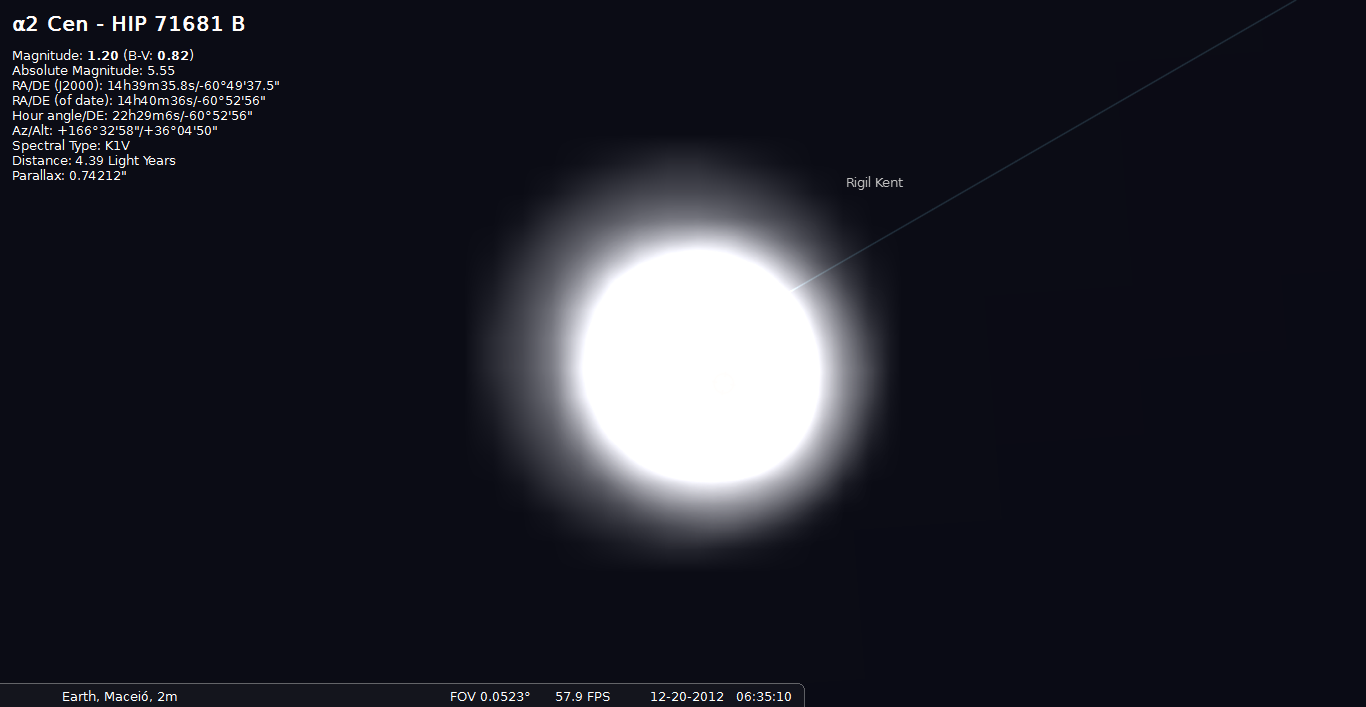
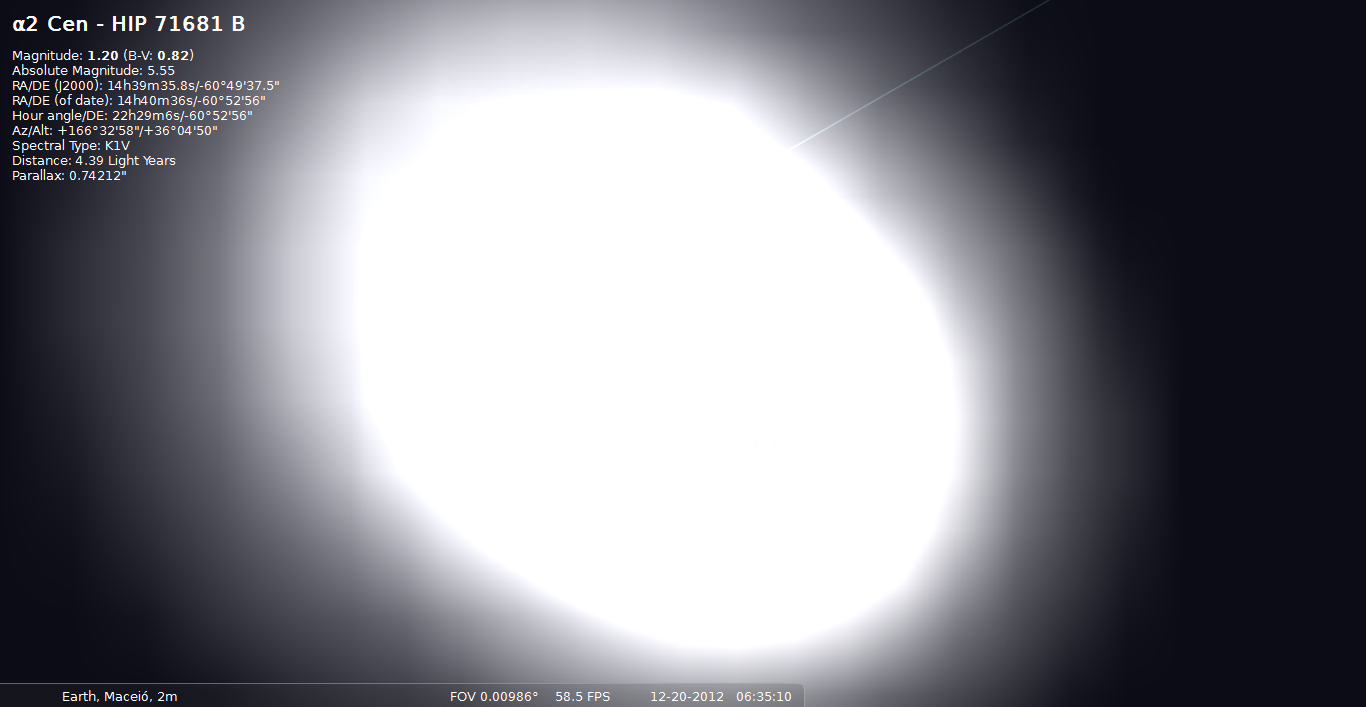
a1 Cen 12-20-12...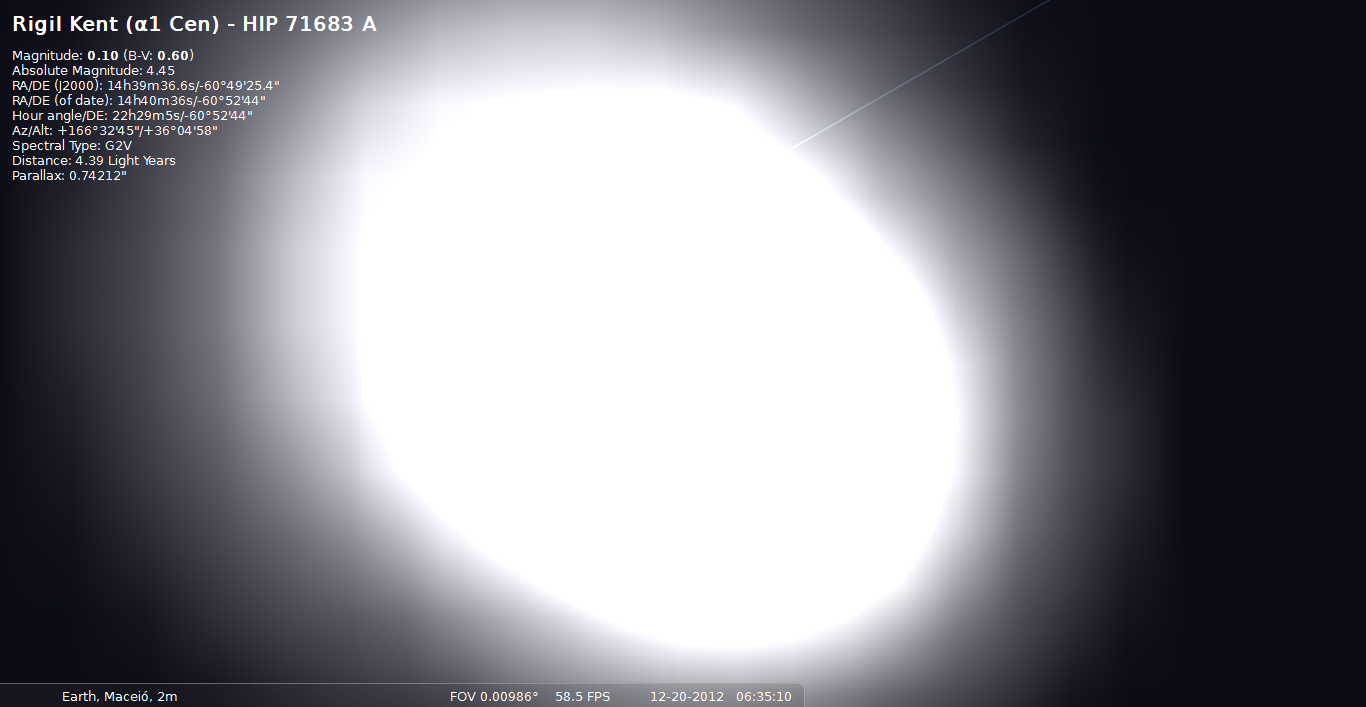
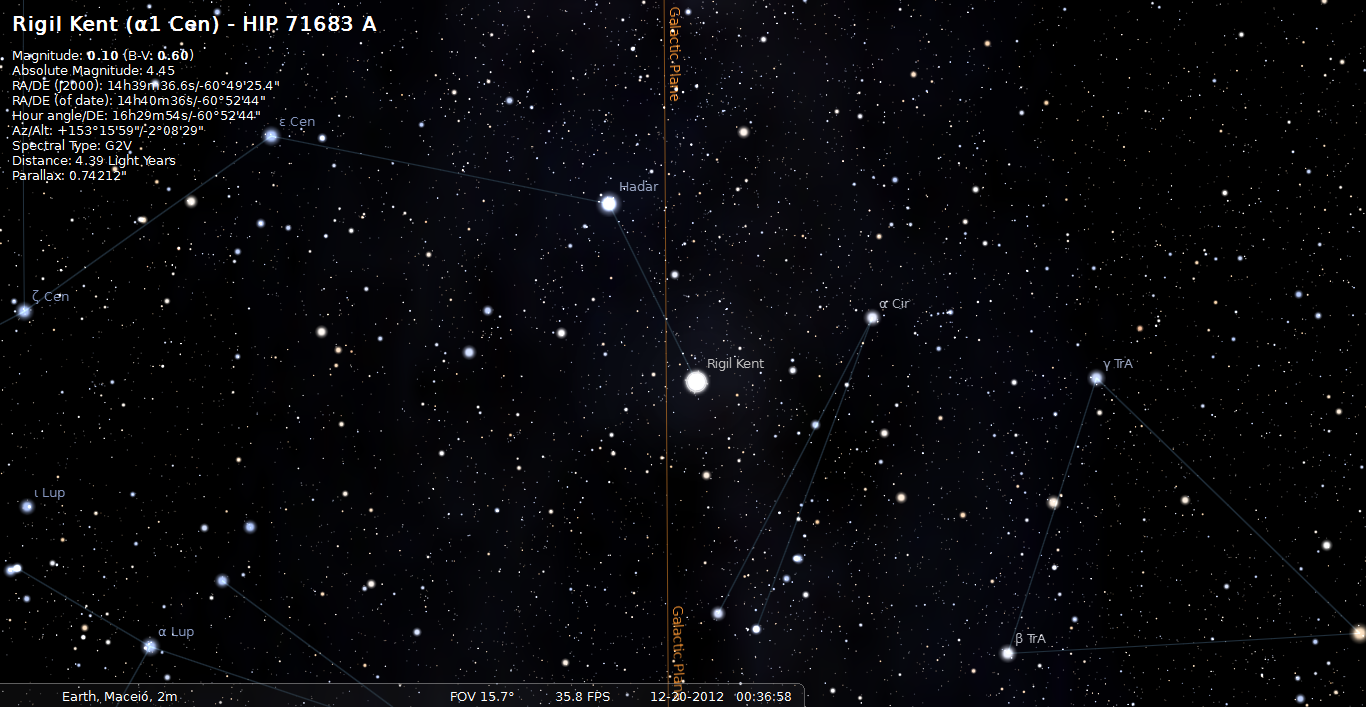
Both on 12-20-3115 BC...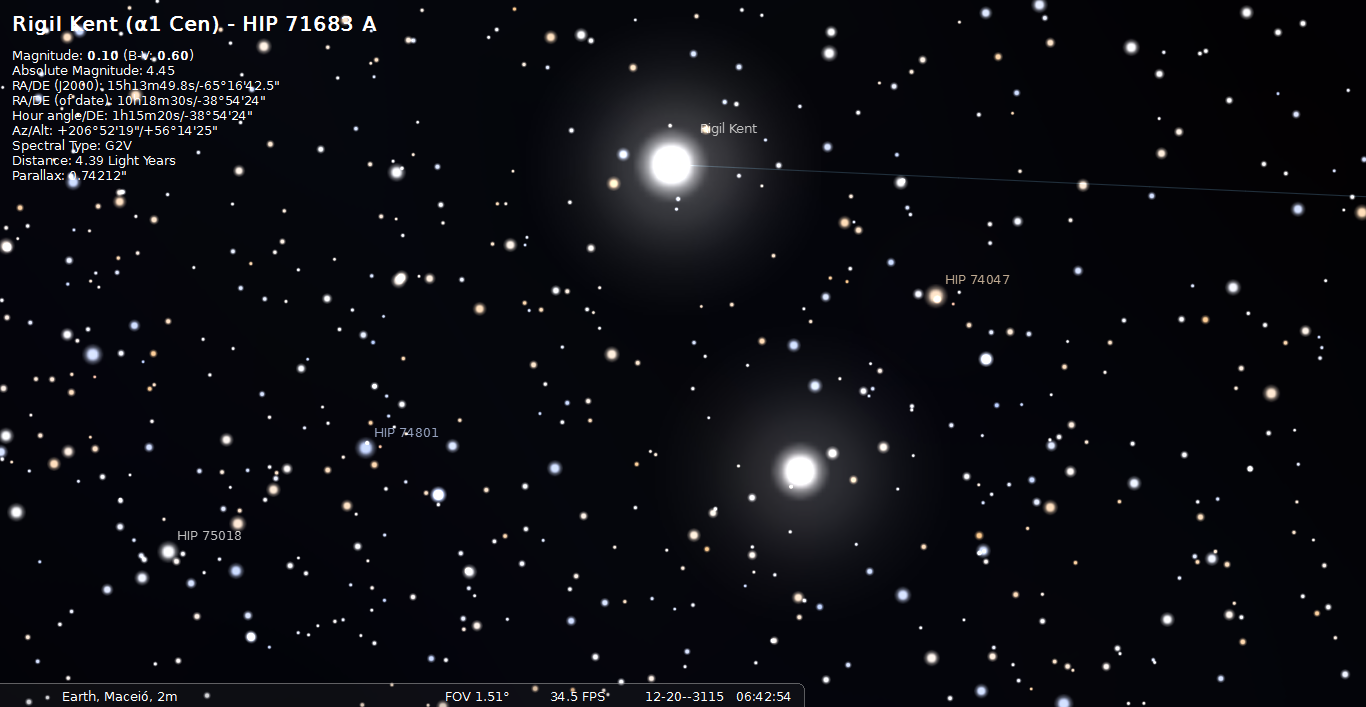
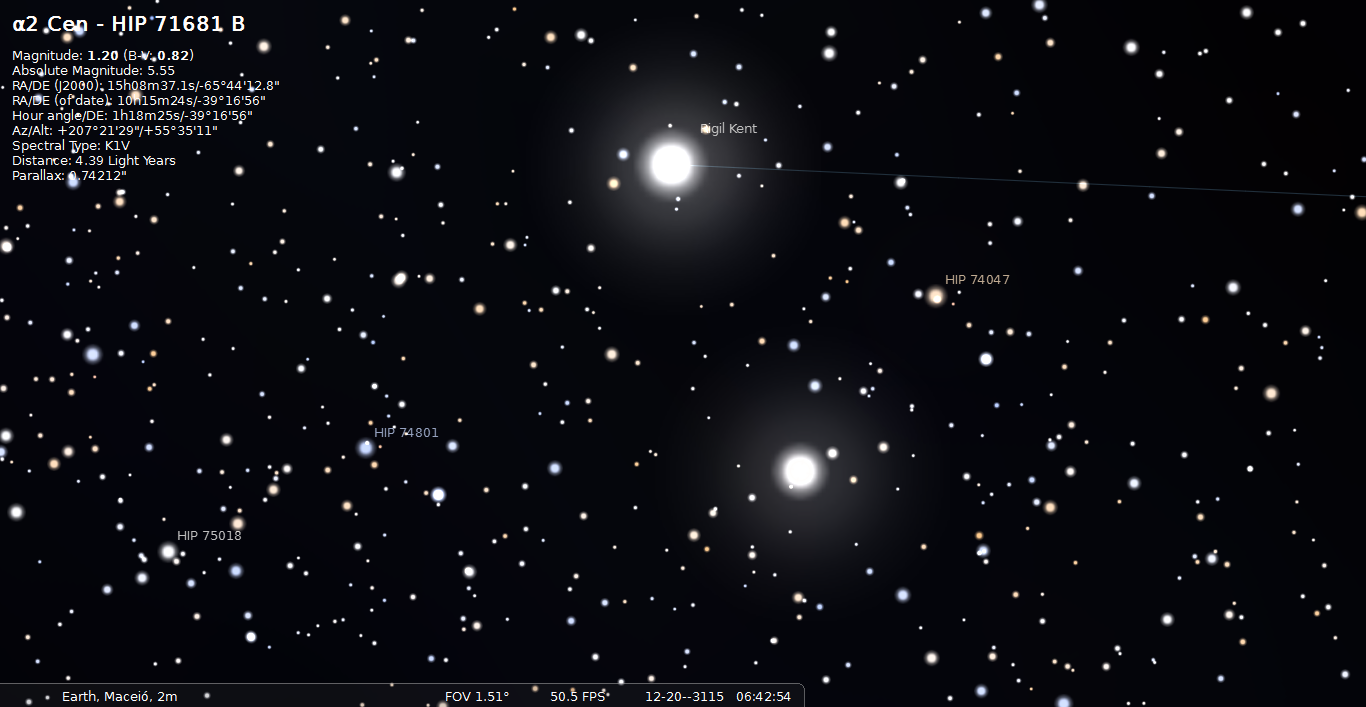
Both on 10-15-1475 (from the Sun)...
Both on 9-24-1550 (from the Sun)...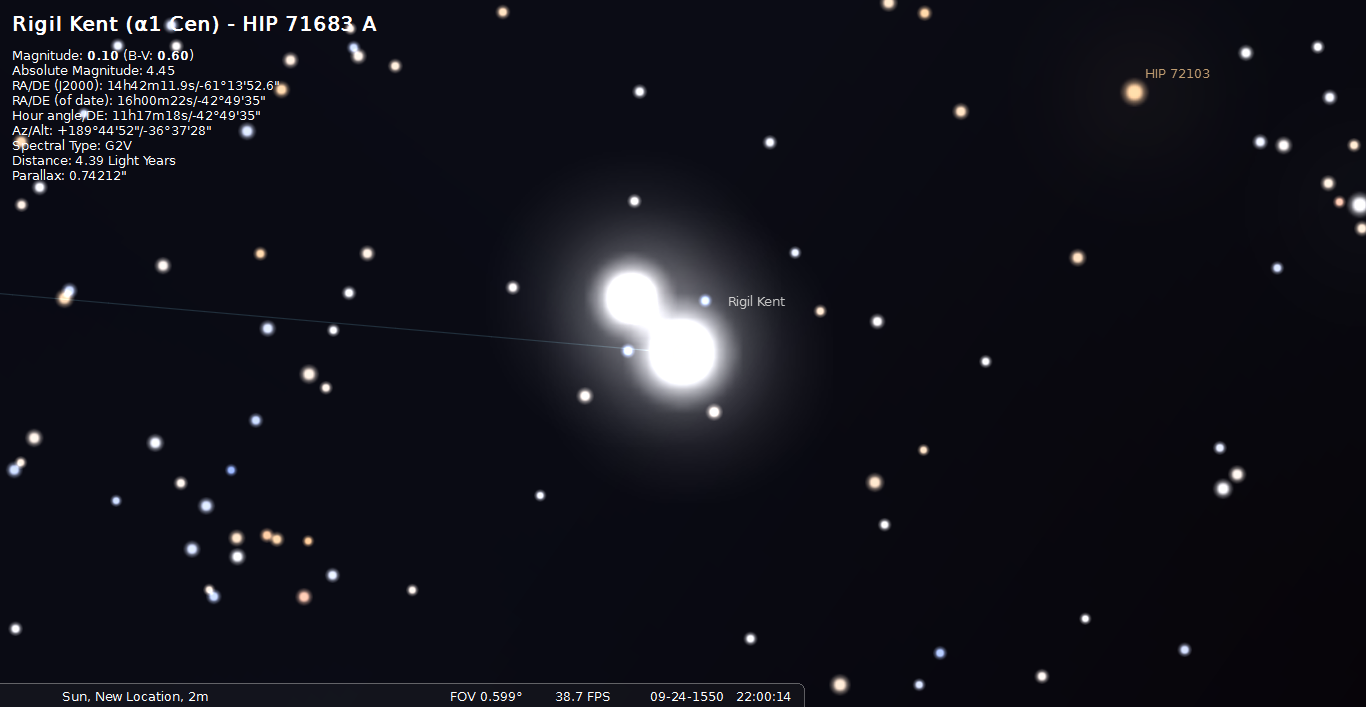
Both on 8-17-1662 (from the Sun)...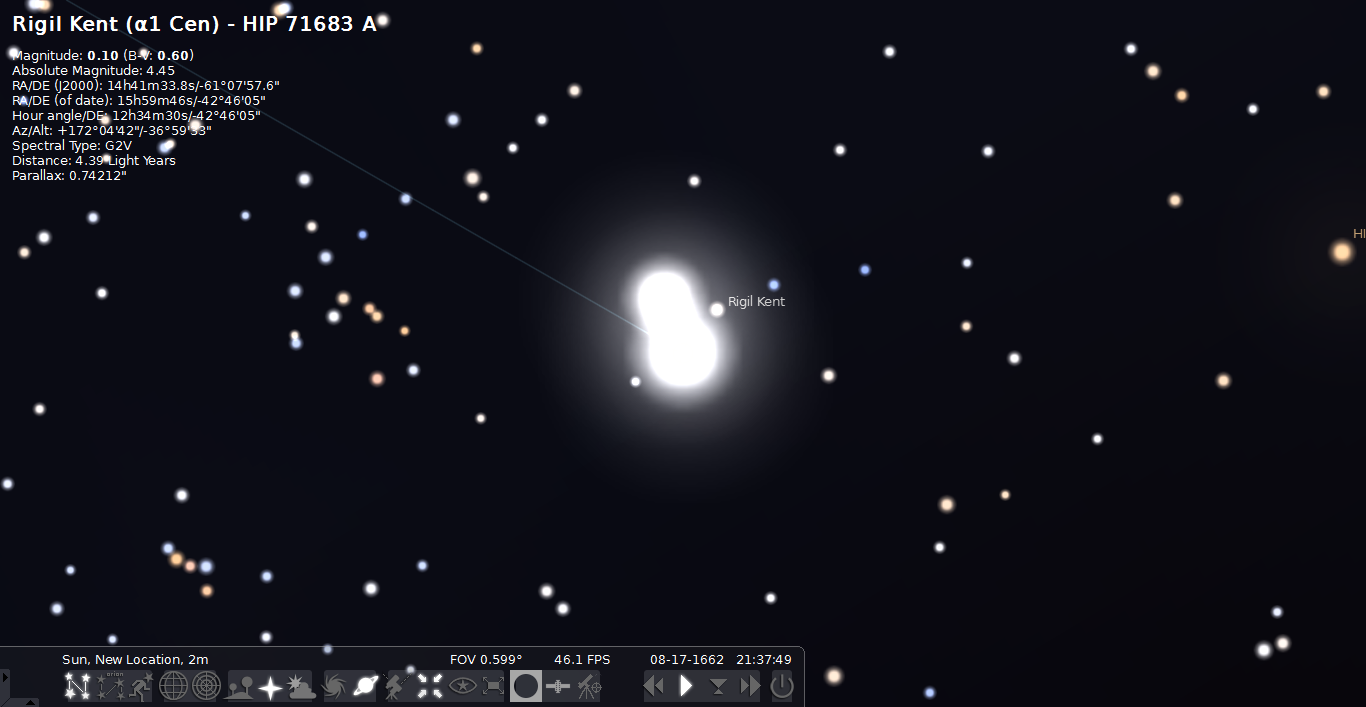
Both on 7-14-1989...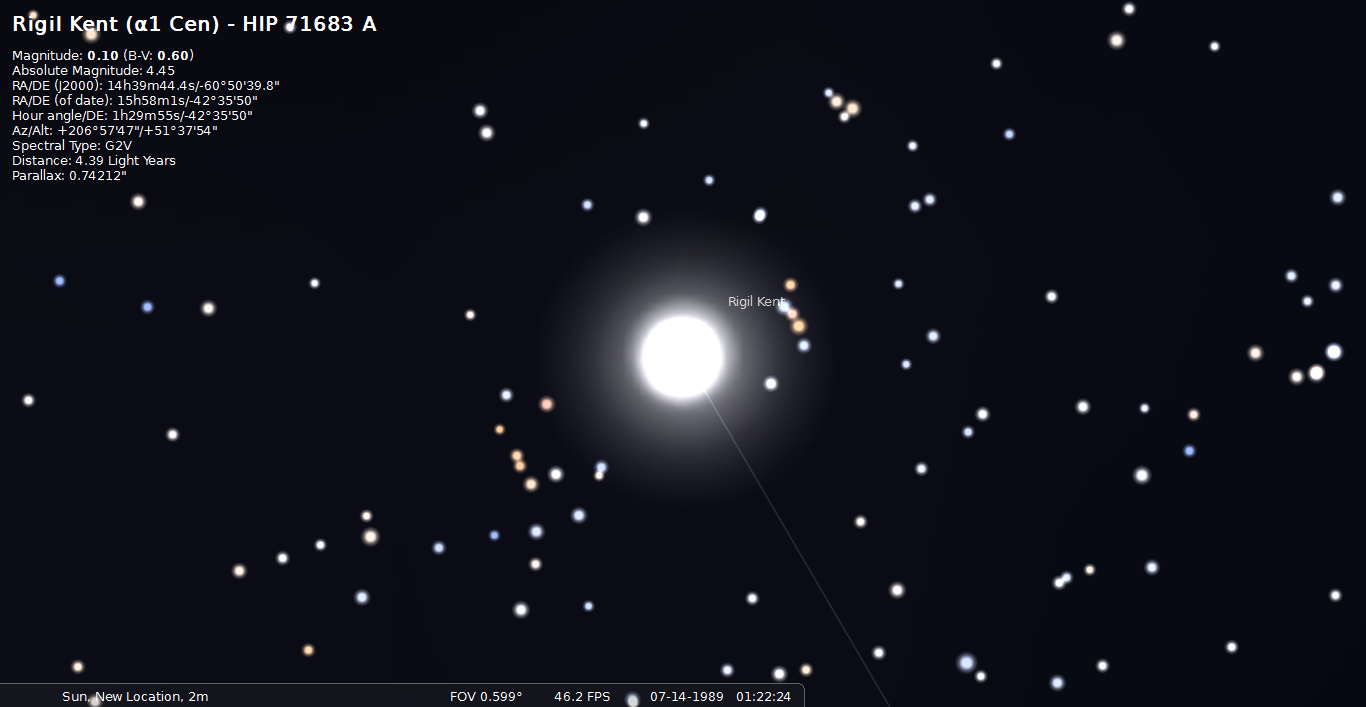
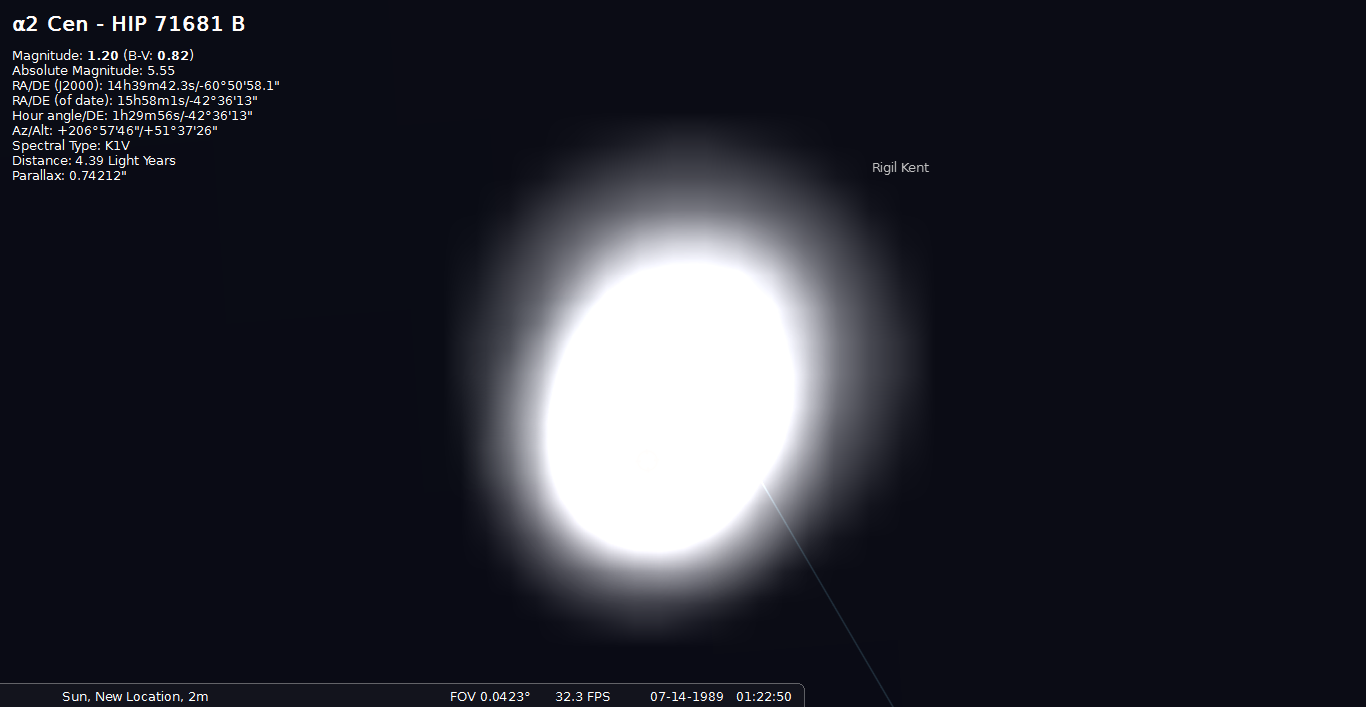
They are both the same distance, 4.39 LY and Today they have appeared to merge into one star. Rigil stays on the Galactic plane always. Which to me means that it is in the center of the Milky Way, I could be mistaken, I am not an astronomer. Our Sun does not stay on the galactic plane (crosses 2 times a year), but it seems to rotate around Rigil, for the purposes of this thread I will stay away from Sirius and Alcyone. Those happen to be my next topic and what I was actually looking at when I stumbled on to this.
Doesn't change from Earth or the Sun view.
BAW33
Now I am sure I will be told by someone how big a moron I am, but oh well...I took some pictures to share.
a2 Cen 12-20-12 (from the Earth)...


a1 Cen 12-20-12...


Both on 12-20-3115 BC...


Both on 10-15-1475 (from the Sun)...

Both on 9-24-1550 (from the Sun)...

Both on 8-17-1662 (from the Sun)...

Both on 7-14-1989...


They are both the same distance, 4.39 LY and Today they have appeared to merge into one star. Rigil stays on the Galactic plane always. Which to me means that it is in the center of the Milky Way, I could be mistaken, I am not an astronomer. Our Sun does not stay on the galactic plane (crosses 2 times a year), but it seems to rotate around Rigil, for the purposes of this thread I will stay away from Sirius and Alcyone. Those happen to be my next topic and what I was actually looking at when I stumbled on to this.
Doesn't change from Earth or the Sun view.
BAW33
edit on 12/20/2012 by BrokenAngelWings33 because: (no reason given)
Rigel Kent, better known as Alpha Centauri is a binary star system (2 stars, A and B).
There is also a third star that is part of the system known as Proxima
There is also a third star that is part of the system known as Proxima
reply to post by BrokenAngelWings33
I won't call you a moron, but even with all those pictures and your colorful text you failed to get a logical point across.
Isn't this the natural cycle?
Now I am sure I will be told by someone how big a moron I am, but oh well...I took some pictures to share.
I won't call you a moron, but even with all those pictures and your colorful text you failed to get a logical point across.
Isn't this the natural cycle?
edit on 12/20/2012 by Corruption Exposed because: (no reason given)
BTW - Just because you may not know a lot about a subject doesn't make you a "moron"
You found something that looked strange to you. Your brought it here and asked questions about it.
So it means you are curious and inquisitive.
You found something that looked strange to you. Your brought it here and asked questions about it.
So it means you are curious and inquisitive.
It's certainly cool to look at. And I don't think anyone is going to fault you for sharing cool stuff.
But as was stated, it is a binary system.
But please, no more blue text on the grey background. It makes my eyes wobbly.
But as was stated, it is a binary system.
But please, no more blue text on the grey background. It makes my eyes wobbly.
Originally posted by eriktheawful
BTW - Just because you may not know a lot about a subject doesn't make you a "moron"
You found something that looked strange to you. Your brought it here and asked questions about it.
So it means you are curious and inquisitive.
exactly. not all of us on ATS are bashers..most just want the truth..thats what i came here for
reply to post by eriktheawful
As well as an Earth-mass planet orbiting Alpha Centauri B (formally discovered just 2 months ago).
In addition to the info found in the Wikipedia article: A Planetary System Around Our Nearest Star is Emerging
Quite a complicated system.
As well as an Earth-mass planet orbiting Alpha Centauri B (formally discovered just 2 months ago).
In addition to the info found in the Wikipedia article: A Planetary System Around Our Nearest Star is Emerging
Quite a complicated system.
reply to post by CLPrime
I think over time we are going to find that planets around main sequence stars is pretty much the norm, and finding these kinds of stars without planets are the rarer breed.
I think over time we are going to find that planets around main sequence stars is pretty much the norm, and finding these kinds of stars without planets are the rarer breed.
reply to post by eriktheawful
It should certainly be the norm. Planets form from the accretion discs around proto-stellar formations. Since this is the norm for star formation, it would stand to reason that this norm would lead to the other norm -- that is, proto-stellar discs should normally (and naturally) give rise to planets.
Any star that does not have planets likely did at one time, but either swallowed them or ejected them at some point. At least, that would be my assumption.
It should certainly be the norm. Planets form from the accretion discs around proto-stellar formations. Since this is the norm for star formation, it would stand to reason that this norm would lead to the other norm -- that is, proto-stellar discs should normally (and naturally) give rise to planets.
Any star that does not have planets likely did at one time, but either swallowed them or ejected them at some point. At least, that would be my assumption.
edit on 21-12-2012 by CLPrime because: (no reason given)
reply to post by BrokenAngelWings33
First off, I think it's really cool that you're using Stellarium to help learn about the sky. I love that program!
Secondly, I'm glad you realize that the software (as a simulation) has its limits.
You have run up against one of these limits. In addition to the location in the sky, Stellarium also includes the stars' proper motion - that is, how far across the sky we see a star move in one year, and in which direction. Distance is an angle measured in arc seconds (1/3600 of a degree) - the Moon, for example is ~1800 arc seconds (or half a degree) as seen from Earth. Direction is an angle from celestial north.
One online reference for Rigil Kent lists a proper motion of 3.689 arcsec/yr (281.1° from north). At that rate, in the 5,126 years from -3115 to 2012, Alpha Centauri would move ~5.25 degrees across the sky.
However, it lists this for both component stars (A & B). I think that Stellarium entered the proper motion for A & B separately. I don't have time to dive into the Hipparcos Catalogue to find these numbers (I'm already late for meeting my family for lunch), but it's safe to assume that they are different, since the stars orbit each other every 80 years. Stellarium models orbits for objects within our solar system (planets, moons, comets, etc.), however for objects outside the solar system it just extrapolates stellar positions based on proper motion.
Thus, instead of showing Alpha Centauri A & B orbiting each other, it shows them moving in straight lines across the sky and diverging. Congratulations - You broke the system!
(Maybe you should ask for your money back. Oh yeah, it's free-ware.)
First off, I think it's really cool that you're using Stellarium to help learn about the sky. I love that program!
Secondly, I'm glad you realize that the software (as a simulation) has its limits.
You have run up against one of these limits. In addition to the location in the sky, Stellarium also includes the stars' proper motion - that is, how far across the sky we see a star move in one year, and in which direction. Distance is an angle measured in arc seconds (1/3600 of a degree) - the Moon, for example is ~1800 arc seconds (or half a degree) as seen from Earth. Direction is an angle from celestial north.
One online reference for Rigil Kent lists a proper motion of 3.689 arcsec/yr (281.1° from north). At that rate, in the 5,126 years from -3115 to 2012, Alpha Centauri would move ~5.25 degrees across the sky.
However, it lists this for both component stars (A & B). I think that Stellarium entered the proper motion for A & B separately. I don't have time to dive into the Hipparcos Catalogue to find these numbers (I'm already late for meeting my family for lunch), but it's safe to assume that they are different, since the stars orbit each other every 80 years. Stellarium models orbits for objects within our solar system (planets, moons, comets, etc.), however for objects outside the solar system it just extrapolates stellar positions based on proper motion.
Thus, instead of showing Alpha Centauri A & B orbiting each other, it shows them moving in straight lines across the sky and diverging. Congratulations - You broke the system!
(Maybe you should ask for your money back. Oh yeah, it's free-ware.)
new topics
-
Musk calls on King Charles III to dissolve Parliament over Oldham sex grooming gangs
Mainstream News: 19 minutes ago -
Grenfell Tower Fire revisited
Mainstream News: 1 hours ago -
The Why Files Lacerta Reveals the Truth of our Creation
Aliens and UFOs: 1 hours ago -
Watts home paranormal activity
Paranormal Studies: 9 hours ago -
So, what is really going on in South Korea ?
World War Three: 10 hours ago -
Congress Says the FBI is Covering Up Vital Info on the Jan 5th 2021 D.C. Pipe Bombs at RNC-DNC.
Political Conspiracies: 10 hours ago
top topics
-
Congress Says the FBI is Covering Up Vital Info on the Jan 5th 2021 D.C. Pipe Bombs at RNC-DNC.
Political Conspiracies: 10 hours ago, 12 flags -
Biden Has New Bizarre Injuries to His Face
Politicians & People: 16 hours ago, 12 flags -
The trial on kids was stopped
Medical Issues & Conspiracies: 13 hours ago, 9 flags -
So, what is really going on in South Korea ?
World War Three: 10 hours ago, 6 flags -
Elon Musk Calls for Tommy Robinson to be Freed - and Takes a Dig at Starmer
Politicians & People: 17 hours ago, 6 flags -
Orbs Appear And Form Triangle On Live Cam.
Aliens and UFOs: 15 hours ago, 6 flags -
Something is not adding up in regards to the H-1B commotion
General Conspiracies: 17 hours ago, 5 flags -
Watts home paranormal activity
Paranormal Studies: 9 hours ago, 3 flags -
Musk calls on King Charles III to dissolve Parliament over Oldham sex grooming gangs
Mainstream News: 19 minutes ago, 3 flags -
The Why Files Lacerta Reveals the Truth of our Creation
Aliens and UFOs: 1 hours ago, 2 flags
active topics
-
Petition Calling for General Election at 564,016 and rising Fast
Political Issues • 191 • : SprocketUK -
Musk calls on King Charles III to dissolve Parliament over Oldham sex grooming gangs
Mainstream News • 0 • : angelchemuel -
The trial on kids was stopped
Medical Issues & Conspiracies • 12 • : McGinty -
Grenfell Tower Fire revisited
Mainstream News • 0 • : angelchemuel -
Elon Musk Calls for Tommy Robinson to be Freed - and Takes a Dig at Starmer
Politicians & People • 9 • : Athetos -
Strange fog all over the northern hemisphere
General Conspiracies • 46 • : ADVISOR -
So, what is really going on in South Korea ?
World War Three • 8 • : Athetos -
Congress Says the FBI is Covering Up Vital Info on the Jan 5th 2021 D.C. Pipe Bombs at RNC-DNC.
Political Conspiracies • 24 • : ADVISOR -
The Why Files Lacerta Reveals the Truth of our Creation
Aliens and UFOs • 0 • : 727Sky -
Tesla Cybertruck Explodes in Front of Trump Hotel in Las Vegas
Mainstream News • 155 • : yuppa
3
